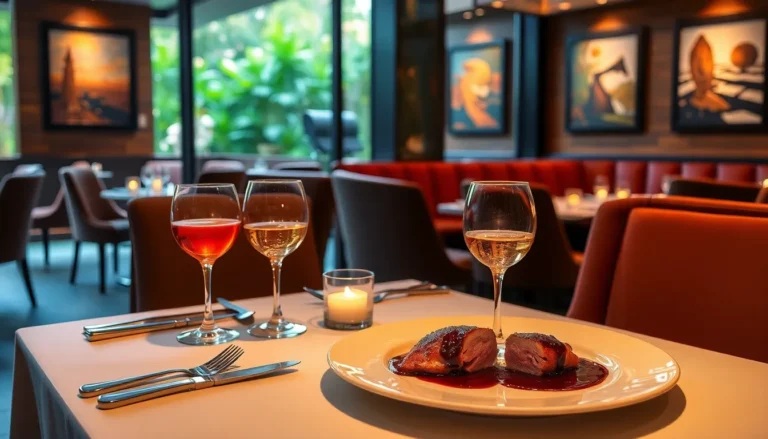Table of Contents
ToggleImagine stepping into a world where every bite takes you on a culinary adventure. The aroma of spices dances in the air while flavors collide in a delightful explosion on your palate. A culinary experience isn’t just about eating; it’s about savoring moments that linger long after the last crumb is gone.
What Is A Culinary Experience?
A culinary experience encompasses various aspects of food enjoyment beyond simple consumption. It’s about the fusion of flavors, textures, and aromas that create memorable moments during meals. Engaging with cuisine stimulates the senses and encourages deeper appreciation of culinary art.
Experiencing different cultures through food plays a significant role in shaping one’s culinary journey. Travelers often seek local dishes and traditional recipes to immerse themselves in the culinary heritage of their destination. Cooking classes offer hands-on opportunities to explore techniques and ingredients unique to a region, enhancing the experience.
Sharing meals with others fosters connection and conversation, making it an essential part of any culinary experience. Guests often bond over the shared enjoyment of food, leading to meaningful interactions. Celebrating special occasions with a carefully crafted menu elevates the dining experience, marking moments in time.
Quality ingredients contribute significantly to a memorable culinary experience. Fresh produce, artisanal products, and seasonal selections often enhance flavors and presentation. Chefs who focus on sourcing local, sustainable ingredients create an unforgettable dining atmosphere through their passion for quality.
In essence, a culinary experience is multi-dimensional, inviting participants to savor food, connect with culture, and engage with others. It celebrates the nuances of cuisine and transforms each meal into an adventure worth cherishing.
Elements Of A Culinary Experience
Culinary experiences thrive on multiple interconnected elements, each contributing to the overall enjoyment of food.
Quality Of Ingredients
High-quality ingredients serve as the foundation of any memorable meal. Fresh produce enhances flavor and nutrition, while artisanal products elevate the dining experience. Locally sourced ingredients often reflect the culture and heritage of a region, allowing diners to engage with local traditions. Organic options, free from harmful pesticides, contribute to healthier dishes. Using seasonal ingredients also ensures that flavors are at their peak, making each bite delightful. Chefs prioritize these elements when crafting menus, leading to more enjoyable culinary experiences.
Preparation Techniques
Preparation techniques significantly influence the taste and texture of dishes. Cooking methods such as roasting, grilling, and steaming each bring out unique flavors. Sous vide, a technique gaining popularity, allows for precise temperature control, enhancing tenderness. Additionally, marinating ingredients before cooking infuses them with flavor, enriching the overall taste profile. Understanding these methods reveals the artistry involved in creating culinary masterpieces. Chefs leverage various techniques to create dishes that excite the palate and emphasize quality ingredients.
Presentation And Plating
Presentation and plating play crucial roles in the culinary experience. Visual appeal captivates diners even before the first bite. Creative arrangements of food, incorporating color and texture, enhance the overall enjoyment. Height and layering can create a sense of movement, while garnishes add sophistication. Attention to detail in plating reflects a chef’s artistry and respect for the meal’s components. A well-presented dish not only excites the appetite but also ignites a sense of anticipation, making the culinary experience even more memorable.
Types Of Culinary Experiences
Culinary experiences come in various forms, enriching our understanding of food and culture. Here are some distinct types:
Fine Dining
Fine dining represents an elevated culinary experience, characterized by meticulous attention to detail. Restaurants in this category focus on elegant ambiance, exceptional service, and high-quality ingredients. Menus often feature gourmet dishes that showcase innovative cooking techniques. Diners frequently explore unique flavor combinations and exquisite presentations. The experience often includes wine pairings, enhancing the overall meal. Locations for fine dining can be iconic establishments known for their renowned chefs or exclusive venues designed to create memorable moments.
Street Food
Street food embodies vibrant culinary traditions found in local communities. Vendors serve quick bites that reflect cultural heritage and regional flavors. Dishes commonly include tacos, kebabs, and dumplings, each offering a taste of authenticity. Prices typically range from affordable to moderate, making these options accessible. The casual atmosphere encourages social interactions as people gather to share meals. Urban areas often highlight thriving street food scenes, allowing for exploration and excitement in diverse flavors.
Cooking Classes
Cooking classes provide interactive culinary experiences, blending education with hands-on practice. Participants learn essential techniques while preparing various dishes. Instructors often share insights on local ingredients and cultural cooking traditions. Classes can cater to different skill levels, from novice cooks to seasoned chefs. Recipes frequently include popular dishes that reflect the cuisine’s essence. Engaging in this experience fosters a sense of community, allowing participants to bond over a shared passion for cooking and food.
The Role Of Culture In Culinary Experiences
Culture plays a vital role in shaping culinary experiences. It influences flavors, ingredients, and cooking techniques, creating unique regional identities.
Regional Influences
Regional influences define the character of many dishes. Geographic locations impact the availability of ingredients, leading to distinct flavors and cuisines. Coastal regions often emphasize seafood, while mountainous areas may focus on hearty meats and root vegetables. Climate affects agricultural practices, resulting in diverse ingredients from one area to another. Local traditions and history further enrich the culinary landscape, resulting in vibrant dishes that tell stories. For example, Mediterranean recipes showcase olive oil and fresh herbs, reflecting the climate and agricultural practices of the area. Visitors exploring these regions engage in diverse experiences that highlight local culture, elevating their culinary journey.
Traditional Dishes
Traditional dishes act as a cultural touchstone, preserving heritage and history. Families often pass down recipes through generations, creating a connection to the past. Dishes like pasta in Italy and kimchi in Korea reveal culinary narratives unique to each culture. These dishes usually feature specific ingredients that celebrate local agriculture, fostering pride among communities. Traditional cooking methods, such as slow braising or fermenting, enhance flavors and showcase techniques passed down over time. Eating these dishes offers an immersive experience, allowing individuals to appreciate the cultural significance and stories behind each recipe. Embracing traditional culinary experiences deepens appreciation for the food and the culture it represents.
Culinary experiences transcend mere eating; they invite individuals to explore the rich tapestry of flavors and cultures that food offers. Each meal presents an opportunity to connect with others and create lasting memories. By embracing the artistry of cooking and the significance of quality ingredients, diners can elevate their enjoyment and appreciation of diverse culinary traditions.
Whether it’s the elegance of fine dining or the vibrancy of street food, every culinary adventure enriches the palate and fosters a deeper understanding of heritage. As individuals savor each bite, they embark on a journey that celebrates not just food but the stories and connections that come with it.








